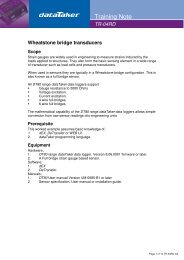You also want an ePaper? Increase the reach of your titles
YUMPU automatically turns print PDFs into web optimized ePapers that Google loves.
The flip-side of this capability is that if you don't want special characters such as \ to be interpreted then they need to be<br />
"escaped". So if you actually want to output a \ followed by a n then the backslash would be escaped by entering it twice, ie.<br />
\\n.<br />
Example<br />
Suppose you are using DeTransfer to enter a DT80 logger program which requests a parameter from <strong>CANgate</strong>, and you<br />
want <strong>CANgate</strong> to return the parameter in the following format:<br />
A\B 15.9 % CRLF<br />
The <strong>CANgate</strong> command to do this might be:<br />
RQST 1 0199 FORMAT "A\\B %f %%\n";RP CR<br />
which is what you would type if you were directly connected to <strong>CANgate</strong> using a simple terminal program such as<br />
HyperTerminal. Note that where literal \ and % characters are required, they have been escaped so that they are not<br />
interpreted by <strong>CANgate</strong>.<br />
To send the above command from the DT80 serial sensor port, the command would be:<br />
1SERIAL("{RQST 1 0199 FORMAT \034A\\\\B %%f %%%%\\n\034;RP^M}")<br />
Note that the DT80 firmware also treats \ and % characters as special. Consequently in order to output the required three<br />
backslash and three percent characters to <strong>CANgate</strong>, it is necessary to escape each of them, as shown. The " character is<br />
also special, so it too must be escaped. In this case the \034 sequence is used to force the output of an ASCII 34 (")<br />
character. (Later DT80 firmware versions also allow a double quote to be escaped using \".)<br />
But DeTransfer also interprets backslash sequences. So in order to send the above string to the logger, you would need to<br />
enter the following into the DeTransfer Send window:<br />
1SERIAL("{RQST 1 0199 FORMAT \\034A\\\\\\\\B %%f %%%%\\\\n\\034;RP^M}")<br />
Serial Sensor Direct Mode<br />
When <strong>CANgate</strong> is connected to a DT80 series data logger, you may sometimes need to interact with the <strong>CANgate</strong> directly –<br />
for example to send a SNOOP command. To facilitate this, the DT80 series data logger incorporates a serial sensor direct<br />
mode (DT80 firmware version 6.08 or later).<br />
To enter this mode, enter the following logger command:<br />
SSDIRECT<br />
A confirmation message should be displayed. Everything you send to the logger connection from now on will be ignored by<br />
the logger and will instead be forwarded to the serial sensor port, ie. to <strong>CANgate</strong>. Furthermore, all normal text output from the<br />
logger (eg. real time data returns) will be discarded and instead any output from <strong>CANgate</strong> will be returned.<br />
To return the logger to normal operation, send the command:<br />
ENDSSDIRECT<br />
and the logger should return a message indicating that serial sensor direct mode has been cancelled.<br />
Using <strong>CANgate</strong> with DeLogger<br />
The <strong>dataTaker</strong> DeLogger software (Version 3 Release 5 and later) provides a way of easily configuring <strong>CANgate</strong> when it is<br />
used in conjunction with a DT80 series data logger.<br />
DeLogger allows you to select parameters of interest from a database. It will then generate a logger program similar to that<br />
described in the previous section. The generated program will set up <strong>CANgate</strong>, then poll it at the specified rate (in<br />
conjunction with any other analog or digital measurements that may be required) and log the results.<br />
DeLogger is supplied with pre-defined databases containing parameter definitions for J1939, OBD-II and NMEA-0183.<br />
These databases are in standard XML (Extensible Markup Language) format, and are readily expandable to cover other<br />
protocols or manufacturer-specific parameters.<br />
For more details on using DeLogger with <strong>CANgate</strong> and a DT80, refer to the "<strong>CANgate</strong> and DT80 Start Here" guide and the<br />
DeLogger on-line help.<br />
Troubleshooting<br />
This section gives a few tips which may assist in resolving problems that may occur when using <strong>CANgate</strong>.<br />
<strong>CANgate</strong> does not respond to commands from host computer<br />
Check that <strong>CANgate</strong> is powered (Power LED is on)<br />
Check that the supplied null modem cable is securely connected between <strong>CANgate</strong> and an RS232 port on the host<br />
computer.<br />
Check that the serial parameters for the DeTransfer (or other terminal program) connection match those set on the<br />
<strong>CANgate</strong> DIP switches (by default 57600 baud, 8 data bits, no parity, 1 stop bit, hardware flow control)<br />
Confirm that you have selected the correct COM port (especially if you are using a USB to serial converter)<br />
When <strong>CANgate</strong> is in non-verbose mode (which is the default), many commands do not return anything to the host.<br />
The VERSION command should always return something, however.<br />
UM-0086-A2 <strong>CANgate</strong> User’s <strong>Manual</strong> Page 33



